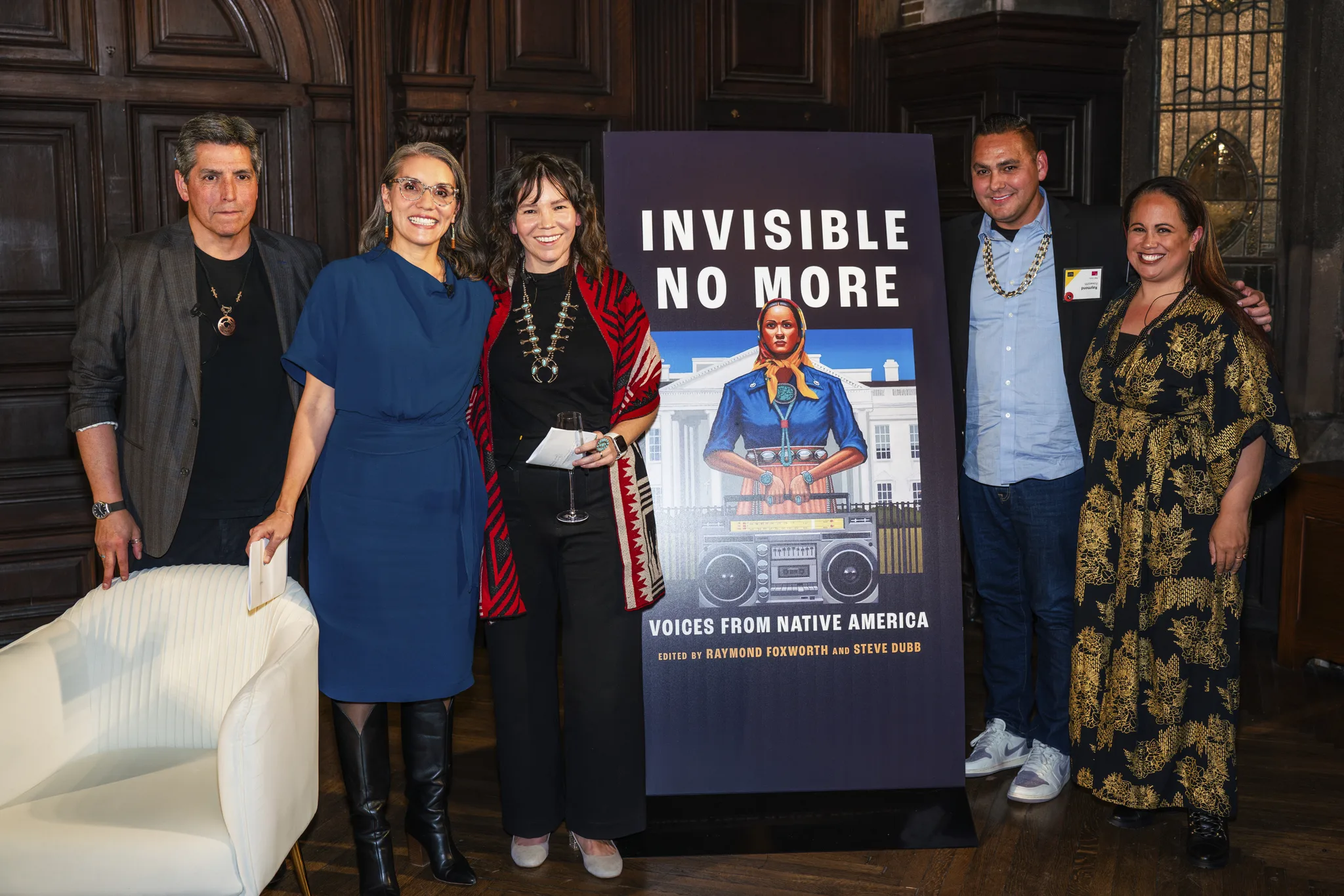Stories of Native community-building can help us redress historic inequities, create more just societies, and cultivate a better world. But far too often, Indigenous narratives are made “invisible” — intentionally and politically co-opted and obscured in an attempt to rewrite history from a colonial perspective.
On December 6, NationSwell and Marguerite Casey Foundation were proud to present “Invisible No More: Voices from Native America,” a book club event celebrating and centering Native American luminaries who are leading in the areas of Indigenous economics, environmental justice, and community-building.
Michael Roberts, Trisha Kehaulani Watson, and Heather Fleming — a few of the essayists who contributed their words and stories to Invisible No More — were joined by Dr. Carmen Rojas, President + CEO of Marguerite Casey Foundation, for a panel on the ongoing impact of genocide and settler colonialism; the racialized upward consolidation of wealth in philanthropy and beyond; and what we can do, both through our institutions and as individuals, to help support Native communities.
Here are some of the key learnings from the event:
+++
Learnings and Insights
- The “invisibility” of native communities is intentional. Any solutions-oriented approach must necessarily acknowledge that many Americans don’t think about Native communities at all, and that that invisibility — and other pernicious narratives about Indigenous populations — is by design; it works to further political interests. Recognizing and naming the violence that has been historically perpetrated against Native Americans contradicts the idea of American exceptionalism in a way that many politicians, private sector leaders, and civilians have a hard time accommodating.
- Social movements involving climate justice must evolve to include Indigenous voices. Having long been the canaries in the coal mine when it comes to raising awareness about the environmental issues that have put us on a path to destruction, Indigenous voices should now be centered in any movement to curb the effects of climate change. Building connections and coalitions with the underfunded grassroots organizations already doing this work on the ground will be an integral step to facilitating change and steering us towards a more environmentally-just future.
- Silicon Valley’s startup mentality and metrics for success are often diametrically opposed to Native values. While America’s tech class is primarily concerned with definitions of wealth that are defined by finance and scalability, Navajo philosophy dictates that wealth is more closely related to the ideas of balance and harmony. The idea of success will look different depending on who’s defining it, and discussing those differences explicitly will help to drive alignment.
- Learn the history of the land you’re standing on. Acknowledging racialized violence and painful colonial histories requires discomfort, but that sacrifice will be required if we are to truly grapple with and understand the challenges Indigenous communities are facing. Asking difficult questions about simple things — like where the water every day comes from or the indigenous name of a place — can be an accessible way to honor native communities and truly begin to grapple with America’s painful history.
- Buy Native goods and services. Investing in Native artisans, creators, and entrepreneurs provides vital cash flow into tribal economies, and also helps to preserve Native culture and history. You can check out shops like Eighth Generation and creators like Daniel John, Marissa Mike for examples of where to buy.
- Building coalitions will be an invaluable part of building a brighter future. Through linking arms with other marginalized groups, Indigenous advocacy orgs. are beginning to see momentum through government initiatives like Justice40, which aims to cascade investments towards disadvantaged communities that are marginalized, underserved, and overburdened by pollution. Strength in numbers helps to create visibility — and with American Indians and Alaska Natives making up less than 2 percent of the U.S. population, that visibility can make a world of difference.
- Write a dang check. There are so many incredible Native organizations doing amazing work on the ground — but Native populations represent such a small percentage of the U.S. population that good allies will be required in order to effect real change. One of the simplest ways to support Native Americans in having the autonomy to solve the problems facing their community is by donating money — the list of grantees listed on First Nations’ website is a great place to start.
- BIPOC cohorts — although a necessary component of the journey toward indigenous justice — still often fall short in many ways. While it is important not to become mired in games of “who’s more marginalized,” it is still prudent to acknowledge the fundamental differences faced by those of Indigenous heritage when compared to other marginalized groups. Rather than being recognized as a purely racial identity, indigenous heritage is also a political relationship with the U.S. government that has historically meant a lack of funding for roads and infrastructure; contentious legislation; a lack of funding for businesses; and much more.
To advance its vision for a society that prioritizes the needs of excluded and underrepresented people, Marguerite Casey Foundation (MCF) has partnered with NationSwell on the MCF Book Club: Reading for a Liberated Future, a quarterly event series promoting authors from historically marginalized populations whose work centers radical, regenerative, and transformative approaches to community-building.
Throughout 2024, Dr. Carmen Rojas (President & CEO of Marguerite Casey Foundation) will interview a series of authors in front of the organizations’ shared audience of field-builders, thought leaders, impact investors, philanthropic grantmakers, elected officials, and heads of social impact and sustainability at some of the nation’s largest private sector companies.

 "
"